 |
|
Kansas Geological Survey Open-file Report 2003-82 |
3.4 Proximate Analysis
The ASTM Book of Standards (2002) describes the process of proximal analysis on coals. Proximal analysis of coal samples used in this study was conducted at Luman’s Lab (Chetopa, KS). To report analytical results including desorbed gas on a dry (moisture free) basis, moisture content must be determined (Figure 3.09). Testing for moisture entails calculating the weight loss of a sample when heated. Moisture ranges from 0.1 to 7.5 % for Cherokee Group coals (Figure 3.09).
Determining ash content involves burning the sample and weighing the residue. Ash is an important indicator of clastic input, likely derived from marine or fluvial deposition of clay, silt and sand during peat development. The moisture-free weight percentage of ash ranges from 7 to 90 % for Cherokee Group coals and carbonaceous shales (Figure 3.10). The Summit, Tebo, and Rowe coals have ash contents that are significantly higher than other coals. When comparing ash contents of subsurface samples with outcrop samples, ash content on average appears to be lower for outcrop samples (Allen 1925; Schoewe, 1959; Brady and Hatch, 1997; also see Figure 3.10). Lower ash contents of outcrop samples may be due to coal deposits being up dip and further away from a marine influence than samples down-dip.
Calculation of sulfur entails mixing part of the sample with Eschka mixture that dissolves with the sulfur in hot water and precipitates it as barium sulfate. The barium sulfate is then filtered, ashed, and weighed. Sulfur and ash content are traditional indicators of coal quality. Coals with a lower ash and sulfur content are generally regarded as higher quality. Coals with higher sulfur contents (> 2.5%) reflect a marine influence (Brady and Hatch, 1997). For Cherokee Group coals, the moisture-free weight percentage of sulfur ranges from 2 to 12.5 % (Figure 3.11). The Mulky, Iron Post, Dry Wood, Rowe, and Riverton coals have sulfur contents that suggest strong marine influence. When comparing sulfur contents of subsurface samples with outcrop samples, sulfur content on average appears to be slightly higher for the outcrop samples (Allen 1925; Schoewe, 1959; Brady and Hatch, 1997; Figure 3.11).
Once calculations for moisture and ash content are obtained, the calorific value (Btu/lb) can be determined on a moist, ash-free basis. Calculating the calorific value involves burning a sample in an adiabatic oxygen bomb calorimeter. Observation of temperature before and after combustion represents the calorific value. The calorific value provides a basis to determine coal rank. Most Cherokee Group coals on a moist, ash-free basis have calorific values greater or equal to 14,000 Btu/lb and are classified as high-volatile A bituminous (Figure 3.12). Cherokee coals with calorific values ranging between 13,000 and 14,000 are classified as high-volatile B bituminous (Figure 3.12). When comparing the calorific value of subsurface samples with outcrop samples, the calorific values for subsurface and outcrop samples are fairly consistent with each other (Allen 1925; Brady and Hatch, 1997; Schoewe, 1959).
Once moisture and ash content are obtained, desorption measurements can be
calculated on a moisture ash-free basis (MAF) and averaged for each coal and
shale sampled (Figure 3.13). Gas contents on a MAF basis range widely from
28 scf/ton to over 360 scf/ton for coals, and 64 scf/ton to 115 scf/ton for
black shales. Gas content may be a reflection of several factors such as coal
quality, rank, depth, association with adjacent source rock, and the amount
and type of organic matter. As shown in Figure 3.14, there is an indication
that gas contents generally increase with decreasing weight percentages of
moisture-free ash. Figure 3.15 supports a relationship between increasing
Btu/lb and gas content. Slight evidence for increasing gas content (MAF) with
depth can be seen in the combined desorption data as well as in the data for
individual wells (Figure. 3.16). Results presented in the previous graphs
are from whole samples rather than multiple samples through each sampled coal.
Individual coals may significantly vary laterally.
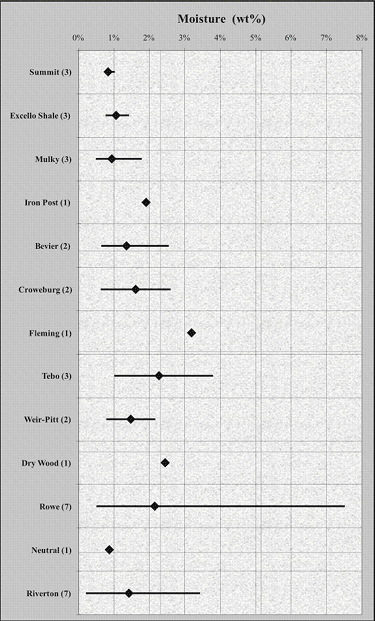 |
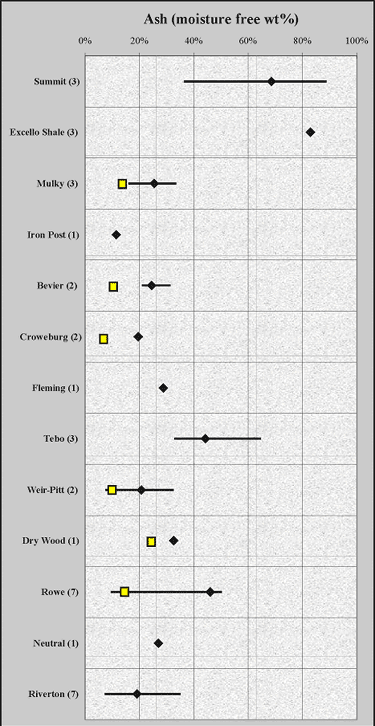 |
| Figure 3.09 - Range and average moisture (weight percentage for coal samples from the Cherokee basin (see Figure 3.02 for sample locations and type). Number of samples indicated in parentheses. | Figure 3.10 - Range and average ash content on a moisture free basis
for coal and shale samples from the Cherokee basin (see Figure 5.02 for
sample locations and type). Samples are compared against the average ash
content of coals along the outcrop belt |
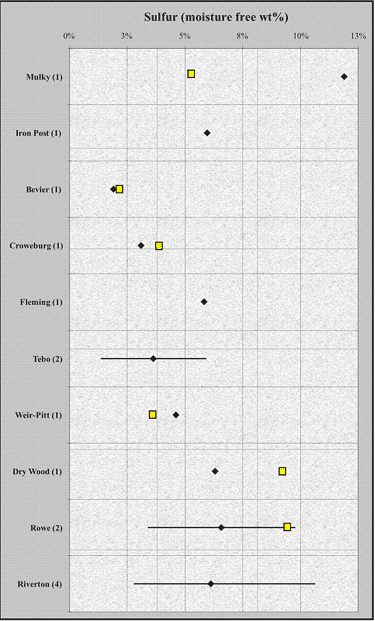 |
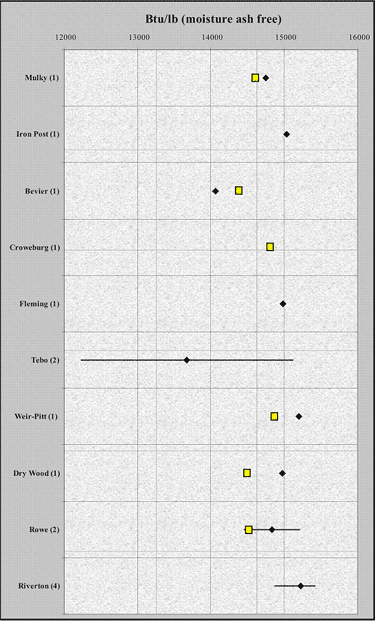 |
| Figure 3.11 - Range and average sulfur content on a moisture free basis
for coal and shale samples from the Cherokee basin (see Figure 5.02 for
sample locations and type). Samples are compared against the average ash
content of coals along the outcrop belt |
Figure 3.12 - Range and average calorific value (Btu/lb) on a moist,
ash free basis. Most Cherokee Group coal have calorific values greater
than 14,000 Btu/lb and would be classified as high-volatile A. Samples
are compared against the average calorific values of coals along the outcrop
belt |
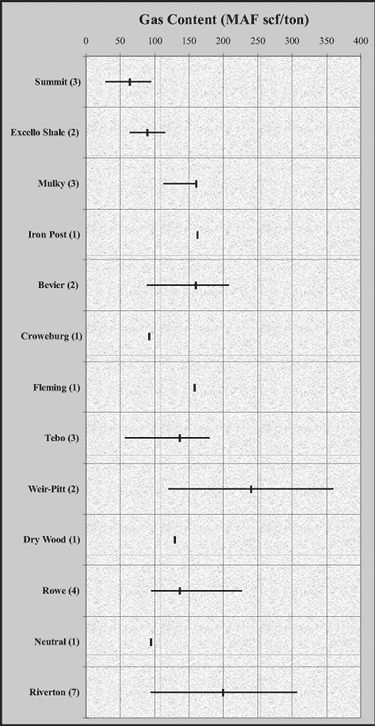 |
| Figure 3.13 - Range and average gas content on a moisture ash free basis for coal and shale samples from the Cherokee basin (see Figure 3.02 for locations and type). Number of samples indicated in parentheses. |
e-mail : webadmin@kgs.ku.edu
Last updated December 2003
http://www.kgs.ku.edu/PRS/publication/2003/ofr2003-82/chapter3_4.html